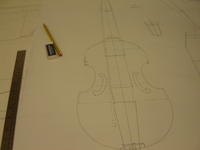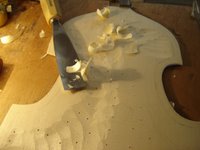About two weeks ago I bought a Harpsichord (Jørgen Bengaard). Of cause it wasn´t new and I consider it more to be a donation since it was very cheap. It wasn´t the harpsichord I was looking for either. I needed one that I could bring with me at any concert I might do. But this was unlike any Harpsichord I have ever seen before. There were foot-pedals (toggles) and 16´-stops and was as heavy as any grand piano (it held an iron frame). But I had to buy it!!! and now I found out that there is absolutely no information saying anything about this kind of instrument. It seems that most early musicians (of our time) would rather that it had never existed! So in the future you will find many posts regarding this particular kind of harpsichord that must have been the obvious choice of instrument for the not-quite-so-early Harpsichordist. My first priority will be to find a recording of the instrument from the time it was build…
Wanting to get a different sound from my cornetto, an oboe playing friend of mine and I mounted a reed instead of the regular mouth piece on it. I wanted more of a crumhorn sound but ended up with something that sounded fantastic on every 20th try and otherwise was really hard to play. Lots of strange sounds coming as well. ![]() But I like the idea.
But I like the idea. ![]() Here are the photos. First the reed, then two full-length versions of my Moeck cornetto with the reed and finally the normal mouthpiece.
Here are the photos. First the reed, then two full-length versions of my Moeck cornetto with the reed and finally the normal mouthpiece.
Sarah Peck has started to build a gamba. It’s all nicely documented on her blog and the progression will be linked in the column to the right. Check out the first entries about the beginning:  and how far she has come today:
and how far she has come today:  Looking forward to following your progress, Sarah. Keep us updated!
Looking forward to following your progress, Sarah. Keep us updated!
In paragraph 23, chapter 4, page 58 of On playing the Flute Quantz writes on intonating:
“The flute has the innate defect that some of its notes when sharpened [playing sharps] are not quite true, some being a little too low, some a little to high. For in tuning the flute you must first see to it that the natural [diatonic] notes are tuned truly in accordance with their proportions. The faulty ones you must, as much as possible, seek to play in tune with the help of your embouchure and your ear.â€?
This is a little note to those who claim that you should play any instrument as is and that some instruments can never be played in tune. Many other instruments have the same problems (i.e. saxophone and recorder) and the players of all the instruments that have these problems should seek to play them as well intonated as possible.
In paragraph 16 he writes: “This defect can be easily remedied, however, if the player possesses a good embouchure, a good musical ear, a correct system of fingering, and an adequate knowledge of the proportions of the notes.â€?
Now, if you’ll excuse me I have to go practice playing in tune
In On playing the Flute paragraph 17 chapter I, page 34, Quantz describes the “flutes d’amour” as a flute that is a minor third lower than the common flute. Funny, as I always imagined it was a name for the voice flute (a recorder in D), being a minor third lower than the alto recorder.
Follow Me
Follow me online and join a conversation